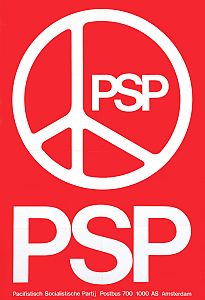Pacifist Socialist Partij
The Pacifist Socialist Partij (PSP) was a Dutch party that existed from 1957 to 1991. She stood ideologically between the Social Democrats and the Communists and joined GroenLinks in 1989/1990 .
history
The PSP was founded in January 1957 by a group of "politically homeless" who sought a position between social democracy and communism and who criticized rearmament and the stationing of nuclear weapons in the Netherlands during the Cold War . The founding members of the PSP rejected both the endorsement of NATO by the PvdA as the strong focus on the well Soviet Union by the communist CPN from. The history of its origins is very similar to the socialist people's parties in Denmark and Norway and the Parti socialiste unifié (PSU) in France, which were founded from 1959 to 1961 and also positioned themselves between pro-Western social democrats and Moscow-loyal communists. These four parties viewed each other as sister parties.
The other main goals of the PSP included the nationalization of large companies, a highly progressive taxation of higher incomes, full employment through reduced working hours, the abolition of the First Chamber and the monarchy or measures against discrimination against ethnic and other minorities. In The Hague , Lambertus Johannes Bot was chairman of the party for five years.
In the 1960s, the PSP enjoyed increasing support from the student movement and undogmatic groups such as the Provos , not least because it took a firm stand against the United States' Vietnam War .
In the 1970s, the PSP was weakened by internal struggles for direction, even during the Uyl cabinet, which was led by the Social Democrats , it remained the opposition on the left.
At the beginning of the 1980s, her decidedly pacifist stance brought her again more support in connection with the growing peace movement and especially the protest against the so-called retrofitting of NATO. It had its highest level of organization in 1982 with almost 10,000 members, but could no longer achieve the election results of the 1960s. With the ebb of this movement, support for the PSP also waned again, which increasingly oriented itself towards cooperation with other small left-wing parties and formed the GroenLinks alliance with them for the 1989 parliamentary elections . When this alliance was officially constituted as a party in 1990, the PSP dissolved itself shortly afterwards.
Many PSP members remained active in GroenLinks and became prominent GroenLinks politicians, such as Kees Vendrik (now Vice-Chair of the parliamentary group in the Second Chamber of the States General ), Joost Lagendijk ( MEP ), Ineke van Gent (Member of the Second Chamber) and Leo Platvoet (Member of the First Chamber). Some former members, who did not want to take part in the transition to GroenLinks, founded the PSP'92 party in 1992, which has remained insignificant, while other former members such as the current MEP Erik Meijer later joined the Socialist Party (SP).
In 1971, the party had the model Saskia Holleman pose naked in front of a cow on an election campaign poster.
Election results of the PSP ( Tweede Kamer )
| year | Voting share | Seats |
|---|---|---|
| 1957 | 1.8% | 2 |
| 1963 | 3.0% | 4th |
| 1967 | 2.8% | 4th |
| 1971 | 1.4% | 2 |
| 1972 | 1.5% | 2 |
| 1977 | 0.9% | 1 |
| 1981 | 2.1% | 3 |
| 1982 | 2.3% | 3 |
| 1986 | 1.2% | 1 |
Individual evidence
- ^ Neil Carter: The Politics of the Environment. Ideas, Activism, Policy. Cambridge University Press, Cambridge et al. 2001, p. 103.
- ↑ Paul Lucardie: Democratic Extremism in Theory and Practice. All power to the people. Routledge, Abingdon (Oxon) / New York 2014, p. 93.
- ^ Mike Feinstein: Sixteen Weeks with European Greens. Interviews, impressions, platforms, and personalities. 1992, p. 316.

